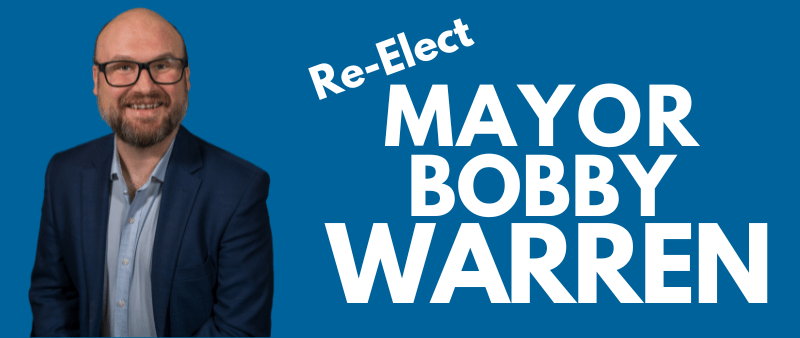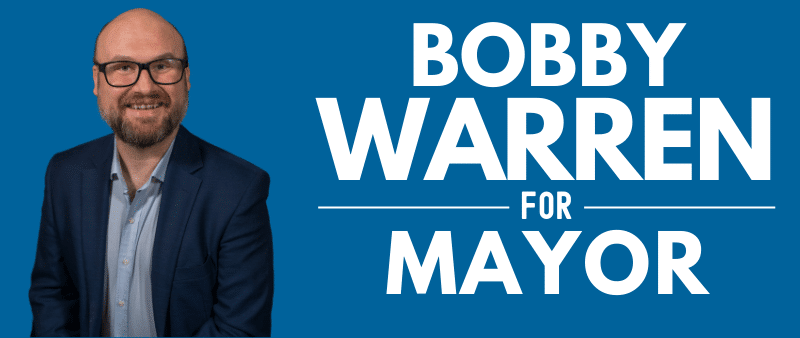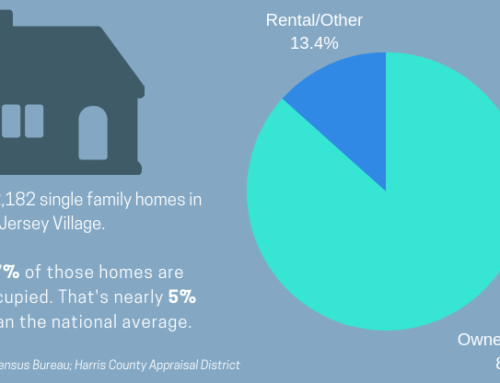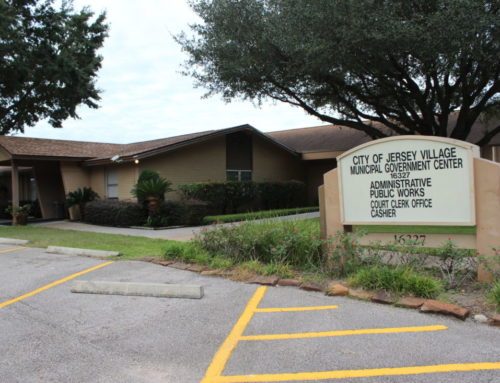This past weekend, while blockwalking in support of my campaign to become the next mayor of Jersey Village, I spoke to an elderly couple who were very concerned. “Do you support the move of city hall across 290?”, the wife asked as her husband looked on. I responded, “Why yes, and I think it’s important to explain why…”
Before I could continue, she asked, “Why would you want to move our police and fire stations further away?”
Unfortunately, this was not the first time I have heard similar concerns, particularly in the last several months. I made it absolutely clear that the police and fire stations were staying right where they are. She responded, “Well, that’s a relief to hear. You know, someone came by with a petition to sign and told us y’all were moving the police and fire over there as well. It didn’t make sense since they are in newer buildings!”
Although I have tried to counter a lot of misinformation in my discussions with citizens over the last several months, and even the last several years since Village Center was announced to the public, it was apparent that a renewed effort was underway to attempt to undermine the development with false claims intended to frighten citizens.
Below you will find some of the more frequently asked questions posed to me by our citizens and my responses.
Is it true that along with city hall, our police and fire departments will move across U.S. Highway 290?
No. This is absolutely false. It also makes zero sense in light of the excellent conditions of both the fire department and police department buildings. Both buildings are much newer than our current city hall and are maintained in excellent condition. City council has continued to make investments in updating the buildings as needed and are in an ideal location to provide excellent service throughout our city. Ask anyone who is telling you that they will be moving to provide some evidence – I assure you that the only thing they can produce is, at best, speculation.
Why has city council decided to move city hall south of U.S. Highway 290?
It is no secret that our current city hall is long overdue for replacement. In 2018, the City of Jersey Village was approached by Collaborate, a development, architecture and project management firm based in Houston. They were looking for a large amount of land in Northwest Harris County to create a mixed-use development to include retail, restaurants, offices, housing and a flagship hotel.
They were also aware that the city was planning to replace city hall in the very near future. They proposed the creation of a “town square” style of development that has grown in popularity throughout the United States. The “town square” concept combines private development with government buildings such as city halls, libraries or civic centers to create a place where citizens can eat, shop and gather. They are modeled after the town squares found in many older and smaller cities found throughout the United States.
In fact, other suburban cities in Texas have found success with this model, including Sugar Land and Southlake.
Why not just let the developer build without moving city hall?
City hall is a key aspect to the design and level of investment being made in Village Center. If city hall is not part of the project, the scale of the project would be dramatically smaller or lower quality, at best.
At worst, if the city pulled out of our agreement to build city hall in Village Center, the entire development could be scrapped. Years of work toward bringing quality retail, offices, and restaurants that citizens have sought out for a very long time would all be lost.
If we truly want to see this development succeed, moving city hall into Village Center is key.
Why did the City of Jersey Village buy the land across the freeway? I heard it had something to do with a lawsuit.
In short, yes, the purchase of the land was related to settlement of two lawsuits regarding some of the city’s re-zoning of the area along Jones Rd. south of U.S. Highway 290. A more detailed breakdown of those lawsuits can be found by clicking here.
Why is the location of city hall not being put to a vote of citizens?
The citizens of Jersey Village enacted a city charter in August 1986 which controls how our city government is operated. It has been amended a few times since then, but one thing has remained true over the nearly 35 years since the charter was adopted: citizens retained the power to propose initiatives on the ballot to voters.
City council can generally only put a question before voters two ways. One is through a charter amendment. In reality, our charter should only be amended to make adjustments in how our city government should be operated and the powers granted to city council and the officers appointed by council. Just as our U.S. Constitution doesn’t generally cover specific policies, neither should our charter.
The other method council has to place a question before voters is by proposing taking on debt in the form of bonds. Our city council has strived to undertake projects without the need to take on additional debt. In fact, our city is on course to be debt-free by 2027. The financial strength that comes from paying cash for projects is something that will benefit current and future citizens for decades to come in the form of lower taxes in the future and flexibility in the event that a financial crisis arises.
You can read more about the ways that citizens can shape policy in our city, both at the ballot box and through city council, by clicking here.
What would it cost the city to issue bonds solely for the purpose of soliciting citizen opinion? Why not simply call for a bond election?
It’s important to point out that issuing municipal bonds is not the same as taking out a home mortgage. Bonds are securities, just like shares of publicly traded companies. They are highly regulated by state and federal law, and ensuring that those bonds are issued and marketed to investors in a manner that is compliant with those regulations is expensive. Tens of thousands of dollars would be spent on bond attorneys, financial advisors, bond trustees.
Moreover, such a method of soliciting citizen opinion could be very confusing for some voters. For example, if someone were supportive of moving city hall into Village Center, but doesn’t support issuance of debt to build a new city hall, they may vote against the measure even though there is no intention of holding debt for any appreciable amount of time.
The state requires an election to issue bonds not because the state wants to give citizens the opportunity to vote on projects. The state wants citizens to have a say over whether debt is issued to fund those projects. Excessive debt can seriously cripple a city for years. That is why state law requires voter approval to issue bonds.
Years ago, citizens were asked to vote on major expenditures. Why isn’t that happening now?
The votes many citizens recall from years ago were not votes on whether to approve or reject projects – they were votes on whether or not the city could take on debt to fund those projects. Our city charter has never given city council the power to place any proposal on a ballot except for bonds or charter amendments.
Citizens rejected the issuance of bonds for a new city hall in 2002. Why should we build a new one now?
The citizens and voters of Jersey Village living here today are not the same citizens and voters that lived in Jersey Village 19 years ago. Pointing to a vote taken before some of our youngest current voters were born is hardly “respecting the will of the people.”
Even among citizens who may disagree with the move of city hall, the vast majority have told me they still support building a new city hall at its current location.
Why haven’t any tenants been announced for Village Center?
Actually, a few already have. Collaborate announced both Marriott and Work Lodge as tenants back in October 2019.
Unfortunately, the pandemic brought much of the progress on Village Center to a pause over the past year. Thanks to much more readily available COVID-19 vaccines and a clear resurgence in the economy, we’re back on track for additional announcements in the next several months.
What happens if those deals fall through? Will City Hall be located in a ghost town across U.S. Highway 290?
No. If Village Center falls through and never materializes, city hall will not be constructed at that location.
Why would you pay for land when you already have city owned land where city hall is currently located?
Once they close on the purchase of the land for Village Center, Collaborate has entered into a written agreement to donate to the City of Jersey Village the land on which the new city hall will be built.
So will I now need to go across U.S. Highway 290 to pay my water bill, purchase by pool pass, get new pet tags, obtain a permit, etc.?
No. As many citizens have quickly discovered during this pandemic, so many of these tasks can be handled entirely online now! There is no reason to go to city hall for most transactions with the city.
Many citizens have expressed a desire to continue paying water bills by dropping off payment. The city will continue to maintain a water bill payment drop box at the current city hall location.
How is the city paying for construction of this new city hall? Will the city incur debt to build city hall?
Construction of city hall will be paid with cash. The land on which city hall will be built will be donated by Collaborate after their purchase of the property.
No debt will be required to build city hall.
It looks like our city council is simply trying to make it more difficult for citizens to attend city council meetings by moving across the freeway.
Not only is this not true, but city council has actually strived to make city government more accessible to citizens over the past four years.
In mid-2017, city council began posting the documentation related to city council meeting agendas online for citizens to read. Citizens get to see nearly all of the documentation council reviews ahead of our meetings. In early 2018, we began broadcasting our city council meetings online. This not only allows you to watch the meetings live, but you’re also able to go back and watch meetings well after they happened in our video archives. Just a few years ago, city council also approved new accounting software which enables citizens to go on the city website and see every single transaction entered into by the city as it is entered into the check registry. You can personally search and account for every single penny of taxpayer money spent.
While I completely understand the frustration of citizens who have enjoyed being so close to city hall that they could walk to council meetings from their house, the new location of city hall will actually be closer for some of our citizens who live closer to Jones Rd. The driving distance from the current city hall location to the new one is only 1.5 miles. The average drive time around 6:30pm (most council meetings start at 7:00pm) between the two locations is 4-7 minutes. Knowing our citizens, they would never let an extra few minutes deter them from being engaged citizens.
What about the train track that runs along U.S. Highway 290? Won’t that make it much more difficult to get to city hall?
Not necessarily. According to a study by the Texas Department of Transportation, an average of 5-10 trains traverse the rail line that parallels U.S. Highway 290. When you’re stuck behind a train, it might feel like they’re a constant nuisance, but the reality is we see far fewer trains than most lines coming into Houston.
Moreover, in the unlikely event a train is moving across that track, there is a way to avoid the line entirely by taking Senate Ave. to the westbound Northwest Freeway feeder and taking a left onto FM 529. You actually travel under the train tracks, after which you can turn right onto Jones Rd. and arrive at Village Center. While the distance from our current city hall location to the new location using this route totals 2.7 miles, the average drivetime on a Monday at 6:30pm on this route is only 6-9 minutes. Yes, that is two minutes longer than the route discussed above, but it’s likely much less than the time it takes for a train to clear that crossing.
At the current location of city hall, I can easily walk or ride a bike to get there. Are there any plans to make the new location easy to access the same way?
Yes. As part of the joint project to deepen the E127 tributary of White Oak Bayou (the portion that runs parallel to Wall St. and Village Dr.), the city and county are hoping to include a walking and biking path along the tributary. One end of the trail would begin at Rio Grande and would continue to Village Center. The distance from Rio Grande to city hall along this path would be approximately 3/4 of a mile. There are no residential properties along that portion of the tributary, so the trail will not run behind anyone’s house.
Part of the design work will include determining whether appropriate clearance below the bridges over the tributary at U.S. Highway 290 can be created as part of the design.
What about the high speed rail that is planned to run along U.S. Highway 290? Won’t that make it difficult to reach city hall?
Not at all. Assuming the high speed rail line is successfully built (the Texas Legislature might have something to say about it), the entire portion of the line running through Jersey Village will run along an elevated viaduct. Traffic will be able to pass easily underneath.
What will happen with the land where city hall is currently located? I heard it was rezoned to residential. Will it be sold to developers?
The land will not be sold to developers. While city council has only very briefly discussed it, the general consensus during the limited discussion has been to focus on continued community use of the land.
While it could be maintained as park space, there is also a possibility that the city hall side of the building could be demolished and the civic center part of the building could be kept and possibly remodeled at some point in the future. Our city has an ever growing demand for general use community space, and that part of the building is newer and in much better condition. Keeping that part of the building would also make it feasible to continue to use it for many of the purposes for which it is used now, such as a polling location for elections, cub scout meetings, Jersey Village Senior Outreach events, and yoga.
Although that land was recently rezoned to District A (which encompasses many different uses, including single family homes, parks and government buildings), the purpose of the rezoning was merely to open up the possibility to encourage the Texas Department of Transportation to build a sound wall between the land where city hall is located now and where the Joe Myers dealerships are currently located. Under the prior zoning district (business use), TXDOT regulations prohibited them from building sound walls between properties where both were zoned of business use.
You can watch video from the city council meeting where the change was discussed with citizens at length by clicking here.
Do you have additional questions about the planned move of city hall across U.S. Highway 290 into Village Center? Fill out the contact form below.





